Because not spending energy is more sustainable than saving it
A bridge between environmental awareness and energy conservation.
Building insulation is a critical component in modern construction, serving as a key factor in energy conservation and efficiency. It significantly diminishes heating and cooling costs, enhances comfort, and contributes to reducing a building's overall environmental footprint by lowering CO2 emissions. Additionally, insulation plays a vital role in soundproofing, fire safety, and impact resistance (depending on the insulation type), making it an indispensable feature for both residential and commercial structures.
There is a lot of talk today about climate change and environmental sustainability. We can think in many ways about it, but what technology now makes available to us is a range of solutions to drastically improve the quality of life within living areas by reducing consumption and thus also the carbon footprint. Hesitating to undertake energy renovation of our existing properties or to invest in new constructions with superior energy efficiency is truly unwarranted.

Home insulation is a responsible choice that enables more effective and economical regulation of indoor temperatures, regardless of external weather conditions. While this measure is traditionally associated with colder regions, it also provides significant benefits in Mediterranean climates, aiding in the reduction of heating expenses and, crucially, preventing the excessive warming of interiors during peak summer months.
Insulating your home not only preserves the value of your investment over time by enhancing energy efficiency and reducing operational costs, but it also provides a hedge against potential fluctuations in future energy prices.
A variety of technical solutions are available for retrofitting existing buildings too, modernising those technical details built to outdated standards, thereby enhancing living comfort, even in very old or ancient UCA protected buildings.
The façades of older homes typically have a U-value of 1.2 W/(m²K) or higher. In contrast, a wall with optimal insulation today can achieve a U-value of 0.2 W/(m²K), meaning that uninsulated walls can lose up to six times more energy.
Can we avoid to waste so much energy? Consider the multitude of possibilities we could achieve with those same resources.
Investing in the most effective measures
The graph demonstrates that the most sustainable investments are those with the lowest implementation costs. Highly complex systems, such as automated indoor air management with heat recovery, represent costly implementations that offer minimal benefits and, over time, are less significant compared to other interventions.
The diagram visually emphasises also the equilibrium between the eco-friendliness of an implementation and its associated costs. It considers factors that are frequently neglected or not fully taken into account in discussions about environmental sustainability and carbon footprints. Here are two examples:
- Adopting a sustainability-focused approach, for instance, involves choosing to erect a smaller home minimizing the construction's carbon footprint through the use of fewer materials, downscaling construction sites, reducing pollution and waste.
A smaller home contributes to a reduced environmental footprint over time, resulting from the less energy required for heating and cooling. - Installing equipment that reduces consumption and emissions, such as an eco-friendly, low-consumption heating & cooling system, can decrease our direct carbon footprint. However, we may not fully consider the environmental impact of the new water heater's industrial production or its eventual disposal.
Strategic interventions to enhance a home's energy efficiency, particularly in retrofitting, often begin with remarkably simple measures that are frequently overlooked due to their perceived triviality. Additionally, homeowners may not always know which aspects of their home play the biggest role in energy loss or contribute to the overheating of interiors by external heat.
Four game-changer awarenesses:
Obtaining an energy audit is crucial. A thermography and a comprehensive visual inspection, will ascertain the ways in which a house is losing energy and assist in prioritizing enhancements. Without this, any improvements would be based on mere speculation;
Begin with the low-hanging fruit. Low-cost improvements often have the greatest impact on energy efficiency, even changing our habits. Minimizing air leakage in your home is an economical move to slash heating and cooling expenses, boosting durability, enhance comfort, yielding fast investment paybacks.
Minimizing losses is key. Air leaks, along with uninsulated basements and inadequately insulated roofs, are major culprits in energy loss. Solid uninsulated roof slabs contribute to the overheating of top-floor rooms during the summer. An energy audit will provide a clear picture of the situation. After addressing the minor issues, you can proceed with insulating façades and replacing windows and doors.
There are no miracle devices. If your home is poorly insulated and prone to drafts, not even the most eco-friendly new heater or air conditioner will manage to help you saving energy.

Energy use or embodied carbon?
When discussing the greening of our homes, it is important to remember that the carbon footprint includes not only the emissions we produce (and we are going to produce in the future) but also those already embedded in every material and technical installation we implement.
When it comes to building materials, it is crucial to recognize that our selections can significantly affect the environment, impacting not just energy savings but also the total carbon footprint of the construction process. For instance, materials that provide optimal insulation might originate from polluting raw materials or require energy-intensive production processes and could pose challenges for disposal or recycling at the end of the building lifecycle.
This is why Attard Bros Construction Materials is focused on marketing products that effectively play a part in reducing the carbon footprint throughout the building cycle, from industrial production to disposal. These materials not only contribute to the reduction of global pollution but also ensure lower emissions upon installation, enhanced breathability, sustainable production processes, and the promise of improved quality in living spaces.

Soprema XPS
Extremely resistant to moisture and with a huge compressive strenght, XPS is the perfect insulation material for inverted roofs and foundations. Sopra XPS is resistant to mould, lightweight and recyclable, it also benefits from BREEAM A rating.

Bacchi TermoKüp
Calcium silicate insulation is the ideal solution for exterior or interior applications due to its special breathability, which makes it ideal for managing humidity in domestic spaces. Totally recyclable and made out from natural prime materials it is VOC free, LEED and EPD compliant. It is also a flameproof material Euroclass A1

Bacchi B/Sana
B/SANA is the calcium silicate and cellulose fibre-based insulation panel for indoor applications that definitively solves mould issues on walls as it is able to increase the internal surface temperature of the wall and lower the relative humidity in rooms thanks to its insulating and hygroscopic performance.
Made out from natural prime materials it is VOC free, LEED and EPD compliant, totally recyclable and non flammable.

Glapor Cellular Glass
Glapor is a plastic-free and eco-friendly insulation material, providing optimal insulating for climate neutral buildings fully recyclable at end-of-life.
Due to glass natural properties Glapor is 100% damp-proof, fireproof and totally exempt from any decay of technical properties, to reliably safeguard the energy concept of your building for generations.

Reach us for information on +356 2141 5332



